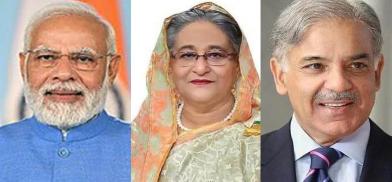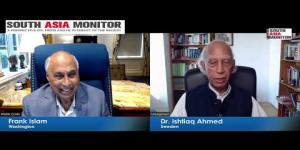The subcontinental dilemma: Should petty politics trump business pragmatism in South Asia?
After all, If India can do more than $100 billion worth of business with China, with which it is now involved in a far more complex border dispute and naval rivalry, then we can at least do business with our next-door neighbours and let consumers have a greater choice.

Last week, Pakistan’s Foreign Minister Mohammad Ishaq Dhar told newspersons in London that his country would “seriously” reconsider reviving trade ties with India, suspended since 2019.
This was an aberration rather than the rule.
Historically, trade has fueled diplomacy and for much of humankind’s existence, has also been one of the main causes of conflicts between nations.
Look at the arrival of the Europeans to the Indian subcontinent. It was in search of trade that the Europeans travelled the seas and used adroit diplomacy – exemplified by the English embassy at the court of Emperor Jehangir in 1615 and violent conflict – Vasco Da Gama’s bombardment of Calicut and the Battle of Plassey – to press their case for the right to trade with India.
However, post-colonial South Asia has been a strange outlier where the usual laws of international relations don’t work. Here more or less, international trade has been hostage to domestic politics, and wars have spoiled trade instead of spurring it.
The fact of the matter is that since Pakistan and India waged a war in 1965, the two sides started restricting trade and travel with each other. And except for brief interludes the two sides never got back to normalising trade, the one lubricant which smoothens all other difficulties elsewhere in the world.
Since the 1990s, India made a case for normalization of trade even as the two sides continued talking over their disputed border. A process which was accentuated by the then Prime Minister Atal Bihari Vajpayee taking a bus to Pakistan to talk about peace and trade.
The Indian attempts were continued by the next Prime Minister Manmohan Singh who famously said “I dream of a day… (when) one can have breakfast in Amritsar, lunch in Lahore and dinner in Kabul.”
However, the Pakistani side remained adamant on talking of the border first and business afterwards.
Sometimes in 1996, India accorded the ‘Most Favoured Nation’ or MFN status to Pakistan which all World Trade Organisation members are supposed to give to fellow members to ensure that everyone faces similar taxes.
Pakistan however dilly-dallied over decades in giving its regional rival India a reciprocal status. Those in the know say this was because in Urdu the WTO term was transliterated to “Sab Se Pasandeeda Qoum” which in Hindustani, the Mughal camp language which later became Urdu, also means ‘bum chum people’.
In a nation where the memory of partition and three-and-a-half wars with India have been kept alive by successive military or military-backed regimes to explain why an impoverished Pakistan must spend huge amounts on its armed forces, giving any favoured trade status even in the sphere of trade, is an obvious political no-no.
The coin flipped after the Mumbai terror attack on November 26, 2008. India started insisting they would talk of as resolution of terror first and everything else could wait for a solution.
The Pakistani ministers and diplomats were then more than eager to talk trade, partly as terror or the control over terror was not in their hands but in those of the army, and partly as Pakistan had started slipping on the economic front.
However, an angry India was then in no mood to listen.
Fast forward to 2019, when the Narendra Modi government in a controversial move abrogated Article 370 of its constitution which gave Jammu & Kashmir a special status, Pakistan stopped whatever trade there was between the two nations. In the same year, India too slapped a 200 per cent tariff on Pakistani imports and rescinded the MFN designation for her western neighbour.
Interestingly, a World Bank report ‘A Glass Half Full: The Promise of Regional Trade in South Asia’ written sometime before these tit-for-tat measures had concluded that Indo-Pakistan trade has the potential to increase to US $ 37 billion if both nations would agree to remove tariff and non-tariff barriers.
However, the two nations’ spat did not end commerce between the two sides. Experts estimate that at least $10 billion worth of goods from India, ranging from Maruti spare parts and libido medicines to tea were routed to Pakistan via Dubai. Pakistani textiles, sugar, marble and semi-precious stones worth $2 billion similarly made their way from the Arabian coast by ship.
Even before 2019, because of the high taxes and negative list of goods which could not be bought from India, most of the trade between the two countries was routed through Dubai and Singapore. In 2018-19, India and Pakistan directly traded goods worth $ 2.56 billion, while another $ 8-10 billion worth of goods were traded by the two neighbours similarly through Dubai and Singapore.
The only ones to complain were traders on both sides. Consumers who lost out as the goods they bought from each other became costlier because of the roundabout manner in which they were shipped remained oblivious of the price they were paying as the two sides refused to talk business with each other.
Politicians had more stake in populist rhetoric which could win them immediate popularity than in the benefits that trade could bring in the long run.
On the eastern border, since Sheikh Mujib’s death, after years of stubborn refusal by the military-led or backed Bangladesh government to open up trade with India, during smugglers had a field day shipping everything from rice to medicines to sarees and cough syrup across the border, trade has normalized and is here to stay.
Two-way trade between India and her close neighbour Bangladesh now stands at a healthy $ 15.9 billion in 2022-23.
Bangladesh which is emerging as a manufacturing powerhouse making goods ranging from garments to pharmaceuticals to ships has started making headway into the Indian market with Made in Bangladesh brands selling in large quantities in the markets of Kolkata, Siliguri, Shillong and Guwahati.
However, the unfortunate twist to the story is that a section of the opposition in Dhaka is trying to stoke a campaign to boycott Indian goods. Luckily for India, Bangladesh’s Prime Minister Sheikh Hasina has tried to take this head-on. Hasina in a public speech this week asked if BNP leaders calling for a boycott of Indian goods were willing to burn the Indian sarees their wives had hoarded.
The video of this speech which has attracted much amusement at the expense of the opposition leaders whose wives are known for their penchant for wearing costly India-made sarees, has been seen by millions of viewers.
It is well known that just as rich Indian consumers have a soft spot for Jamdani and Dhakai silks from Bangladesh, that country’s uber-rich have a love affair with Indian chiffons, Chanderis and Banarasi sarees.
South Asia needs more pragmatic, pro-trade leaders like Hasina. Hopefully, after the dust settles on India’s elections and Pakistan’s newly elected leaders find their bearing, their respective governments will do a Hasina and put aside the pent-up hard feelings that both sides have built up since the partition of 1947 and talk business.
After all, If India can do more than $100 billion worth of business with China, with which it is now involved in a far more complex border dispute and naval rivalry, then we can at least do business with our next-door neighbours and let consumers have a greater choice.
(The author is a senior New Delhi-based journalist. Views are personal. He can be contacted at jrchowdhury@yahoo.com )














Post a Comment